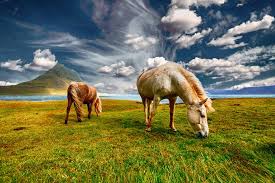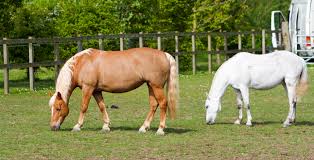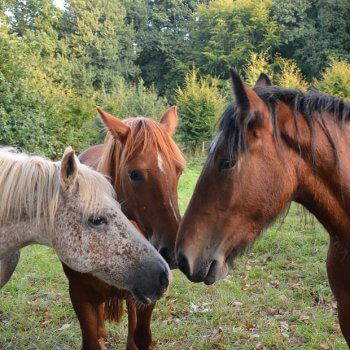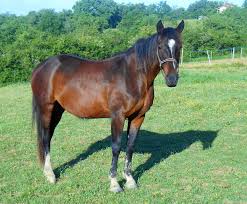It is a sad truth that anyone who intends to keep their horse forever will have to face the end of its life at some stage. Even those with a youngster, a horse on loan or one which they plan to rehome in the future should be aware of end-of-life options because illness or accidents can happen at any time and at any age. This is a situation which most owners would prefer not to think about, but one which can be made less painful if the appropriate plans have already been put in place and you know where to go for support.
Responsible horse ownership and welfare often focus on the aspects of care in giving your horse a good life but equally important is the responsibility to make sure they have a good death when the time comes.
The latest research from Advancing Equine Scientific Excellence (AESE) showed that only 1 in 8 horses die of natural causes, which means in the other 7 cases the decision to euthanase will have to be made either electively or in an emergency. In the case of any death, regardless of whether it is due to euthanasia or natural causes, there are matters that need to be considered and this is far easier to do in advance of any problem.
Considering your horse’s quality of life is imperative when thinking about euthanasia and whilst it is not an easy decision to make, the implications in delaying it can have a much greater impact on their welfare and on your peace of mind.
Even though your horse might be young and healthy, and even though you are sure you’ll have him for many years to come, it is still sensible to make a plan now. World Horse Welfare, the British Horse Society and the Blue Cross have a range of information and advice available to support and guide you through every step of the way in fulfilling the ultimate act of responsible ownership.
How many horse owners make a plan just in case?
 Whenever we travel on a plane, there is always a safety briefing before take off. We all know what the plan is in case of emergency and we would be concerned if the journey didn’t start with this information. It doesn’t mean for a second that we think we will need to use it.
Whenever we travel on a plane, there is always a safety briefing before take off. We all know what the plan is in case of emergency and we would be concerned if the journey didn’t start with this information. It doesn’t mean for a second that we think we will need to use it.
But we pay attention, just in case.
So why don’t we do the same with the horses we love so much? Even though your horse might be young and healthy, and even though you are sure you’ll have him for many years to come, it is still sensible to make a plan just in case, just like you would on a plane. If the worst happened and your horse suddenly got ill or injured, how many of us know what to do? Calling the vet is obvious but what then? What if the vet does everything they can but you are left with no choice but to have your friend put to sleep? What if you are away and someone else is caring for your horse – do they know how you would like things to be handled? What if your horse dies suddenly of natural causes? Understandably, none of us want to think about this but by making a plan now, just in case and when we have no need for it, we could save ourselves a lot of distress. Making a plan doesn’t mean you’re going to use it any time soon – but it does mean that if the worst happens, you’ll know what to do.
There are two key things to plan for, even though those plans might need to change when the time comes. The first is the way in which the horse is put to sleep and the second is what happens afterwards.
When deciding how to put a horse to sleep there are two main options to consider. One is an injection and the other is by gun. The circumstances at the time may make the decision for you but it is important to know the facts about both options, firstly so that you can decide which is best for your horse and secondly, so that you know what to expect should the time come. It is very important to consider which is best for the horse rather than for the owner. For example, the injection may not be the best option for horses which hate needles but may be preferable of the two if the horse is headshy.
Understandably this isn’t something that owners like to think about but it helps to know what actually happens with each method, as well as what to expect. Certain things which are completely normal in this situation can be very frightening for an owner if they aren’t prepared. When a horse is put to sleep by injection it is given an overdose of anaesthetic which will render it unconscious before it slips into a coma and dies – this can only be done by a qualified vet. The vet may sedate the horse first before administering the anaesthetic drug. The anaesthetic will be given either by needle or through a catheter in the neck and the horse will then fall to the ground. The way this will happen varies: some horses will sit back on their haunches before falling onto one side; others will fall onto their side immediately; some will stagger first. Once on the ground, the horse will be very deeply asleep but it is common to see muscle twitching along their flanks and there can also be movement of the legs. Some will gasp which can be a shock to the owner but the horse is deeply unconscious and not in any distress, discomfort or pain. The vet may administer a follow-up injection at this stage, although there is no need to be concerned if they don’t. The horse’s eyes will open, the pupils will dilate and the eye will go glassy – the vet may touch the horse’s eye gently to check for a reflex and may also use a stethoscope to check that the heart has stopped beating. When a horse is put to sleep by gun, a free bullet is discharged into the brain causing instantaneous death: this can be done either by a vet or by another licensed individual. Depending on the circumstances, a vet may administer a mild sedative first although it is not uncommon for no sedation to be used. The horse is dead the instant that the bullet is discharged – this is very important to remember as their body may continue to react in a number of ways. Firstly, the legs will usually ‘snatch’ up underneath the body and the horse will fall to the floor.
 In some cases, the legs will stiffen and the horse will fall sideways or backwards. Most horses will bleed from the nose, some from the wound and some from the ears. It is fairly common for the horse to sweat afterwards and there is often ‘paddling’ of the legs and twitching or contraction of other muscles. All of these can continue for several minutes and are part of the body’s natural response. Although the horse is dead, the heart may continue to beat for as much as ten minutes afterwards. This can be distressing for the owner but is part of the process and does not mean that the horse is still alive. As with the injection, the horse’s eyes will open, the pupils will dilate and the eye will go glassy. It is worth giving some thought to the location. Unless there are welfare reasons to the contrary, it is generally better to move the horse whilst it is alive rather than afterwards. When deciding on the location you will also need to consider whether your horse is going to be buried or collected (see overleaf) as the location may need to have access for a large vehicle. If you keep your horse on a yard of other horses, try to find an outside area away from the main yard which is quiet and private. If the horse is going to be shot, remember that the noise may be upsetting for people to hear. Remember also that there will be some blood on the ground. On an area of hard standing, you should have a hosepipe available to wash this away On grass, you may wish to have some earth available to cover it up. If there is going to be a delay before the horse is collected, it is useful to have a rug available to cover him until this point. If the horse has a close companion, it may be helpful to give them time to see the horse afterwards and accept that they have gone. However, don’t be distressed if the companion seems unconcerned by the loss of their friend as this is a very normal reaction.
In some cases, the legs will stiffen and the horse will fall sideways or backwards. Most horses will bleed from the nose, some from the wound and some from the ears. It is fairly common for the horse to sweat afterwards and there is often ‘paddling’ of the legs and twitching or contraction of other muscles. All of these can continue for several minutes and are part of the body’s natural response. Although the horse is dead, the heart may continue to beat for as much as ten minutes afterwards. This can be distressing for the owner but is part of the process and does not mean that the horse is still alive. As with the injection, the horse’s eyes will open, the pupils will dilate and the eye will go glassy. It is worth giving some thought to the location. Unless there are welfare reasons to the contrary, it is generally better to move the horse whilst it is alive rather than afterwards. When deciding on the location you will also need to consider whether your horse is going to be buried or collected (see overleaf) as the location may need to have access for a large vehicle. If you keep your horse on a yard of other horses, try to find an outside area away from the main yard which is quiet and private. If the horse is going to be shot, remember that the noise may be upsetting for people to hear. Remember also that there will be some blood on the ground. On an area of hard standing, you should have a hosepipe available to wash this away On grass, you may wish to have some earth available to cover it up. If there is going to be a delay before the horse is collected, it is useful to have a rug available to cover him until this point. If the horse has a close companion, it may be helpful to give them time to see the horse afterwards and accept that they have gone. However, don’t be distressed if the companion seems unconcerned by the loss of their friend as this is a very normal reaction.
What happens next?
With a smaller animal such as a dog or a cat, owners are often able to bury them at home or ask their vet to arrange for a cremation. However, many horses are put to sleep at their yard so arrangements need to be made, in advance if possible. Owners with their own land often like to bury their horse at home but you will need to check with the local authority before making arrangements. You must obtain permission for burial from your local council, as the location of water courses and other issues need to be considered. Once permission is granted, there are still certain issues to think about and regulations to follow. For example, a horse will usually need to be covered by at least 1 metre of soil and your local council can advise on this. This means that many owners will need to source a mechanical digger and operator. The person who is putting the horse to sleep must be aware that the horse is being buried as this may influence the location chosen. Fallen stock collectors (also known as ‘knackermen’) will collect horses as well as other animals. The average cost of this service is around £200 and many will put the horse to sleep for no extra charge. Only a vet is licensed to administer medication so if a horse is put to sleep by a fallen stock collector this would be by gun. As fallen stock collectors are used regularly by farmers they are very experienced in putting animals to sleep.
Horse owners can use the National Fallen Stock Collection scheme — www.nfsco.co.uk The most economical option may be to take your horse to an abattoir (although there are only a few in the UK which currently deal with horses). Some people shy away from this option but it can be worth considering, especially if money is an issue as the abattoir may pay the owner rather than charging a fee. These are professional places where the welfare of the horse is paramount. If you have any concerns, give your nearest abattoir a call to find out what you should expect if you take your horse to them. Remember that you will not be able to consider this route if your horse has been given certain medicines (such as bute) or is unfit to travel. If the declaration within the passport has been signed as ‘not intended for slaughter for human consumption’, this cannot be reversed and makes it impossible for the horse to be taken by an abattoir at any stage.
 Some hunt kennels will take in horses although this has declined in recent years and will depend on any medication the horse has been given. Some are able to put horses to sleep but, as with fallen stock collectors, they are not able to inject. Owners would need to contact their local hunts to find out if they offer this service and what the costs are. Finally, you can have your horse cremated and a number of options are available. Most crematoriums will be able to collect your horse and offer three main services: communal cremation where your horse would be cremated as part of a group and no ashes would be returned; communal cremation with token ashes returned (this would be a small quantity of ashes from the cremation so may not be from your horse) or individual cremation where your horse would be cremated alone and their ashes returned to you. Most crematoriums offer wooden caskets with a name plaque and many will also have the option of scattering the ashes in a memorial garden. The price of these services can range from approximately £300 for communal cremation with no ashes to around £900 for individual cremation. Options and prices will vary so you will need to contact your local pet crematorium for information. Remember that most insurance policies will not cover the full cost of even the simplest cremation.
Some hunt kennels will take in horses although this has declined in recent years and will depend on any medication the horse has been given. Some are able to put horses to sleep but, as with fallen stock collectors, they are not able to inject. Owners would need to contact their local hunts to find out if they offer this service and what the costs are. Finally, you can have your horse cremated and a number of options are available. Most crematoriums will be able to collect your horse and offer three main services: communal cremation where your horse would be cremated as part of a group and no ashes would be returned; communal cremation with token ashes returned (this would be a small quantity of ashes from the cremation so may not be from your horse) or individual cremation where your horse would be cremated alone and their ashes returned to you. Most crematoriums offer wooden caskets with a name plaque and many will also have the option of scattering the ashes in a memorial garden. The price of these services can range from approximately £300 for communal cremation with no ashes to around £900 for individual cremation. Options and prices will vary so you will need to contact your local pet crematorium for information. Remember that most insurance policies will not cover the full cost of even the simplest cremation.
Making the decision If there is a real emergency, such as severe colic or a serious injury, you may have no choice but to have your horse put to sleep. However, most owners are faced with what is potentially an even more difficult decision – a slow decline in health and quality of life. So what does ‘quality of life’ actually mean? In reality, it will mean a different thing for each horse. For example, some are quite happy to spend their days in a field, whereas others are only truly happy when they can be worked regularly. Because we see our horses every day, it can be incredibly difficult to spot the many tiny changes that can happen. When thinking about quality of life, you need to consider what is ‘normal’ for your horse. One of the best ways to do this is to keep a diary or notes on the individual things he does that make him your horse. Does he come to greet you in the field? Does he always have a roll or a canter around when you turn him out? How does he behave with his companions? Does he lie down in the stable or is he the kind of horse who never lies down? Does he become distressed or difficult to handle if he isn’t worked regularly? If you keep a note of all those little things your horse does, it will be easier to spot if he stops doing them. Whilst you might not worry if one or two little things change, you might need to consider his quality of life if these start to add up. It is also useful to take photographs of your horse at fairly regular intervals so you can look back at these to see if there are any noticeable changes. This can be particularly relevant as a reminder of their condition if they struggled through the previous winter. Sometimes owners can be tempted to try and rehome their horse if they are no longer able to keep them, either because of personal circumstances or because the horse can no longer be ridden. However, unless the horse is genuinely fit and well, this is not necessarily in their best interests. If the horse is older or has a condition which will worsen over time, it is often better to have that horse put to sleep rather than rehome them to face an uncertain future. It is not uncommon for owners who have rehomed horses in such a situation to worry about where the horse has ended up and to wish they had been brave enough to make the only decision which would guarantee their horse never fell into the wrong hands.
Making the decision to have a horse put to sleep is very difficult, but putting it off doesn’t make it any easier. In a situation of gradual decline, avoiding the inevitable can lead to owners wishing they had been brave enough to make the decision earlier. As well as being difficult to assess quality of life, it can also be surprisingly hard to discuss with friends and family. People close to you can often be almost as attached to your horse as you are, but they probably don’t spend enough time with them to notice the small changes that you see and this can make it very difficult for them to understand why you might be considering his future. In this situation, it can be very helpful to speak to someone completely independent who can listen to your concerns and help you decide whether the time has come. Owners are always welcome to call our Advice Line on 01953 497238 to talk things through.
Search
Recent Articles
Categories
- Advice Hub
- Athlete
- Carriage Driving
- Dentistry
- Dressage
- Endurance
- Eventing
- Farrier
- Featured
- Featured Horse Ads
- Featured Posts
- Horse Racing
- Horse's Mouth
- Horseball
- Hunting
- Le Trec
- Leisure Riders
- Mounted Games
- Nutrition
- Polo
- Polocrosse
- Reining
- Rescue & Rehabilitation
- Show Jumping
- Showing
- Tack Room
- Team Chasing
- The Pony Club
- Therapy
- Training
- Vaulting
- Veterinary





